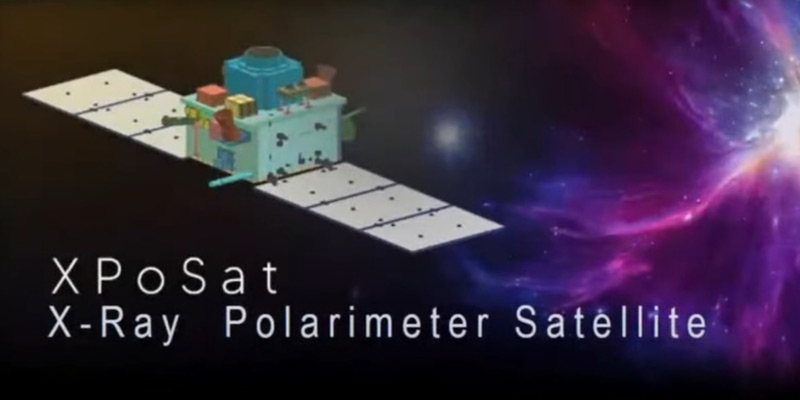- India
- May 27
What is XPoSat?
The Indian Space Research Organisation (ISRO) is collaborating with the Raman Research Institute (RRI), Bengaluru, to build the X-Ray Polarimeter Satellite (XPoSat) that is scheduled to be launched later this year.
What is polarimetry?
• Polarisation is a property of light seen across all wavelengths in the electromagnetic spectrum.
• Polarised light carries unique details about where the light comes from and what it passes through. Light is made up of interconnected waves of electric and magnetic fields that interact with each other in a way that makes them oscillate, or vibrate, at right angles to the path the light is traveling. The vibrations can be up-and-down, side-to-side, or anywhere between.
• Light from a typical bulb, for example, produces electric fields that vibrate every which way. If the light is scattered or reflected by particles or surfaces, the light can become polarised – with vibrations aligned in just one direction.
• Polarimetry, a technique to measure the polarisation of light, is a powerful tool that allows astronomers to infer information about celestial objects, from passing comets to distant galaxies, that can not be obtained using other techniques.
• Polarimetry allows astronomers to observe and measure characteristics of objects that are not always identifiable when using other techniques.
Nasa’s IXPE
Imaging X-ray Polarimetry Explorer (IXPE), launched in December 2021, is NASA’s first mission to study the polarisation of X-rays from many different types of celestial objects. Measuring the polarisation of X-rays traces the story of where this light came from, including the geometry and inner workings of its source.
What is the purpose of XPoSat?
• XPoSat (X-ray Polarimeter Satellite) is India’s first dedicated polarimetry mission to study various dynamics of bright astronomical X-ray sources in extreme conditions.
• The emission mechanism from various astronomical sources such as blackhole, neutron stars, active galactic nuclei, pulsar wind nebulae, etc originates from complex physical processes and are challenging to understand.
• While the spectroscopic and timing information by various space based observatories provide a wealth of information, the exact nature of the emission from such sources still poses deeper challenges to astronomers.
• Polarimetry measurements offer an excellent diagnostic tool for comprehending the emission processes from various astronomical sources.
• By combining polarimetric observations with spectroscopic and timing measurements, researchers anticipate overcoming the limitations of present understanding of astronomical emission processes.
• The polarimetry measurements add two more dimensions to our understanding, the degree of polarisation and the angle of polarisation and thus is an excellent diagnostic tool to understand the emission processes from astronomical sources.
• The polarimetric observations along with spectroscopic measurements are expected to break the degeneracy of various theoretical models of astronomical emission processes.
• The spacecraft will carry two scientific payloads in a low earth orbit.
1) POLIX
• The primary payload POLIX (Polarimeter Instrument in X-rays) will measure the polarimetry parameters (degree and angle of polarisation) in medium X-ray energy range of 8-30 keV photons of astronomical origin.
• The X-ray polarimeter is being developed by Raman Research Institute (RRI), Bengaluru in collaboration with U.R.Rao Satellite Centre (URSC). The instrument is made of a collimator, a scatterer and four X-ray proportional counter detectors that surround the scatterer.
• The scatterer is made of low atomic mass material which causes anisotropic Thomson scattering of incoming polarised X-rays. The collimator restricts the field of view to 3 degree x 3 degree so as to have only one bright source in the field of view for most observations.
• POLIX is expected to observe about 40 bright astronomical sources of different categories during the planned lifetime of XPoSat mission of about five years.
• This is the first payload in the medium X-ray energy band dedicated for polarimetry measurements.
2) XSPECT
• The XSPECT (X-ray Spectroscopy and Timing) payload will give spectroscopic information in the energy range of 0.8-15 keV.
• It can provide fast timing and good spectroscopic resolution in soft X-rays. Taking advantage of the long duration observations required by POLIX to measure X-ray polarisation, XSPECT can provide long-term monitoring of spectral state changes in continuum emission, changes in their line flux and profile, simultaneous long term temporal monitoring of soft X-ray emission in the X-ray energy range 0.8-15 keV.
• An array of Swept Charge Devices (SCDs) provide an effective area >30 cm2 at 6 keV with energy resolution better than 200 eV at 6 keV.
• Passive collimators are used to reduce the background by narrowing the field of view of XSPECT. XSPECT would observe several types of sources viz X-ray pulsars, blackhole binaries, low-magnetic field neutron stars (NS) in Low-Mass X-ray Binaries (LMXBs), active galactic nucleus and magnetars.
Manorama Yearbook app is now available on Google Play Store and iOS App Store

